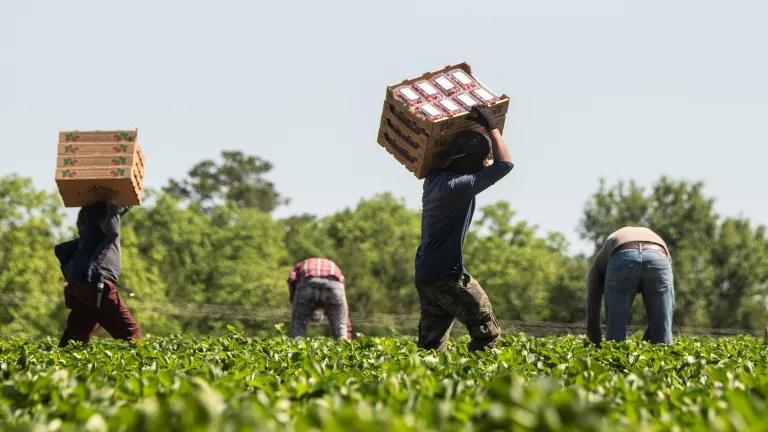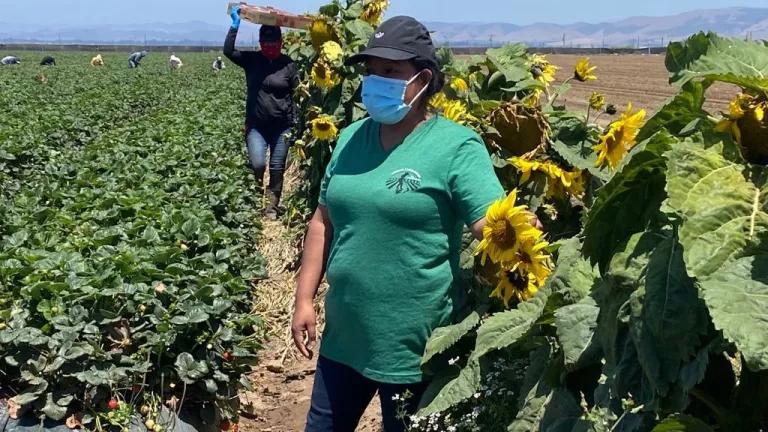Farmworkers Deserve a Bigger Say in Pesticide Safety Rules
To promote equity, EPA must engage farmworker advocates in the earliest deliberations on new pesticide restrictions.

Workers carrying boxes of freshly picked strawberries at Lewis Taylor Farms in Fort Valley, Georgia, on May 7, 2019
To promote equity, EPA must engage farmworker advocates in the earliest deliberations on new pesticide restrictions
EPA is nearing the end of a comprehensive safety review of every pesticide approved for use in the United States. Under a law passed in 2007, Congress directed EPA to re-evaluate the safety of existing pesticides by October 2022. Over the next 18 months, EPA will finish reviewing hundreds of pesticides, determining which ones can stay in use and under what conditions.
For most pesticides, this will be EPA’s first reassessment of health risks and environmental harms in more than a decade. This review is much needed; subsequent research and real-world data often prove pesticides to be more harmful than EPA previously believed.
As it reviews older pesticides through this process, EPA often imposes new “mitigation measures,” intended to lessen the threat those pesticides pose to workers, consumers, or the environment. Mitigation measures can include things like instructing farmworkers not to enter treated fields for a period of time after pesticide application, or a requirement that workers wear protective equipment when spraying pesticides.
There’s a major problem in how EPA chooses new mitigation measures for existing pesticides: it almost always negotiates these requirements with pesticide industry representatives only, behind closed doors. If the public has a chance to comment, it’s after EPA and the industry have already reached a tentative deal. That doesn’t provide a fair opportunity for other voices to be heard.
In particular, EPA’s approach sidelines those with the biggest stake in the question of pesticide safety: farmworkers and their families. Farmworkers face serious health threats from pesticide exposure. Farmworkers also comprise an undervalued and vulnerable workforce: at least a third of farmworker families earn incomes below the poverty line, and few farmworkers have employment benefits. More than eighty percent of farmworkers identify as Latino or Hispanic, and roughly half of hired crop farmworkers lack legal immigration status.
EPA should include farmworker advocates in the earliest stages of debate and deliberation about what new safety restrictions to impose on a pesticide’s use. EPA’s current practice is inconsistent with the principles and commitments of the Biden-Harris Administration.
President Biden’s executive order on protecting public health and the environment announces the Administration’s policy to “advance environmental justice” and “limit exposure to dangerous chemicals and pesticides.” In a second executive order, the President instructed agencies to embed equity into their programs.
In line with these orders, EPA Administrator Michael Regan recently directed agency staff “to improve early and more frequent engagement with pollution-burdened and underserved communities” affected by EPA policies. And one of the basic tenets of environmental justice is that people should have an opportunity to participate in decisions about activities that may affect their environment or health. But as things stand, farmworker advocates can comment on proposed pesticide safety measures only after the pesticide industry has signed off.
It’s especially important to engage farmworker advocates early on because EPA seldom deviates from the proposed mitigation that it negotiates with industry representatives. As it turns out, the mitigation measures EPA adopts are often untested and later prove to be ineffective. That’s perhaps not surprising, given the skewed process through which they’re devised.
EPA should make immediate changes to its pesticide re-assessment process, to give farmworkers at least an equal voice to industry representatives when EPA is deciding on new safety measures. Farmworkers have far more on the line; it’s their health at risk. This is a perfect example of the type of early engagement with pollution-burdened and underserved communities that the Administrator has called for.



